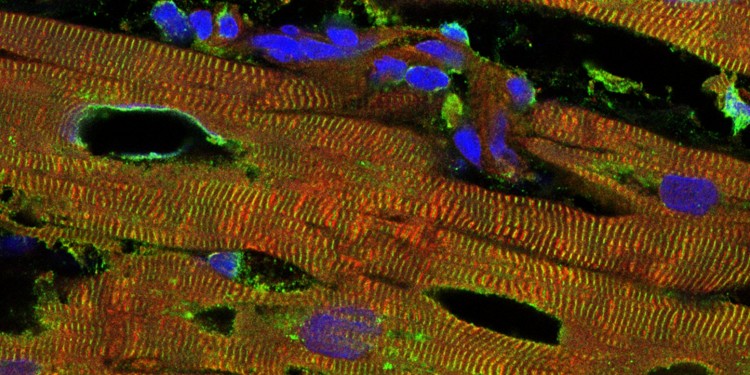
Newly discovered mechanism regulates myocardial distensibility
A healthy heart beats 50 to 100 times a minute and pumps 8,000 litres of blood around our body every day. A precondition for this function is the elasticity of the cardiac walls, which dilate as blood flows in (diastole) and contract again as the blood flows out (systole). Millions of tiny cavities in the heart muscle fibres, the sarcomeres, are responsible for this movement. These contractile units contain the largest protein found in the human body called titin. It has the function of a mechanical spring, which develops a restoring force during the extension of the sarcomeres – just like a rubber band.

Background and method
In the human organism, titin forms the backbone of the sarcomeres, the smallest functional units of the skeletal muscles and the heart. Titin provides both stability and elasticity to muscle cells, due its unique structure. For the first time, the research team has now shown in heart tissue of mice that oxidative stress together with the extension of the heart modulates the spring function of titin. Oxidative stress occurs when too many reactive oxygen species are present in the cell of an organism. These oxygen species, which include so-called free radicals, can cause cell damage. In small quantities, however, they regulate important physiological functions.
The researchers used a mass spectrometer to determine the oxidation status of the proteins in the heart, including titin. Additionally, they isolated heart muscle cells from deep-frozen tissue of a human heart and attached them to a force sensor and a micromotor, in order to stretch the specimens. This enabled them to measure the forces generated upon stretch and observe their increase or decrease during different forms of oxidative stress. In addition, the team produced recombinant titin molecules and also mutated them in a test tube, such that oxidation could no longer occur. “We then used a so-called atomic force microscope to directly measure the effects of stretch and oxidation on the titin spring,” Wolfgang Linke explains. “Using this device, we were able to stretch individual titin molecules like a rubber band and record the force upon extension , as well as the changes in force in the presence of an oxidant.”
The researchers demonstrated in their experiments that the UnDOx mechanism occurs in hearts under oxidative stress. This is the case, for example, after an acute heart attack or in chronic heart disease associated with altered cardiac filling. “The mechanism regulates the distensibility of the heart,” Linke adds. “Extensive wall stiffness is not good for the heart, because less blood flows in. In the case of diastolic heart failure, which is often found in elderly people, the stiffening of the heart is a major problem. We hope that such hearts can be made more distensible through the pharmacological regulation of titin oxidation, i.e. by using medication.”
The work was funded by the German Research Foundation (DFG)
Original publication
Christine M. Loescher, Martin Breitkreuz, Yong Li, Alexander Nickel, Andreas Unger, Alexander Dietl, Andreas Schmidt, Belal A. Mohamed, Sebastian Kötter, Joachim P. Schmitt, Marcus Krüger, Martina Krüger, Karl Toischer, Christoph Maack, Lars I. Leichert, Nazha Hamdani, Wolfgang A. Linke (2020): Regulation of titin-based cardiac stiffness by unfolded domain oxidation (UnDOx). Proc Natl Acad Sci USA. Doi: 10.1073/pnas.2004900117
